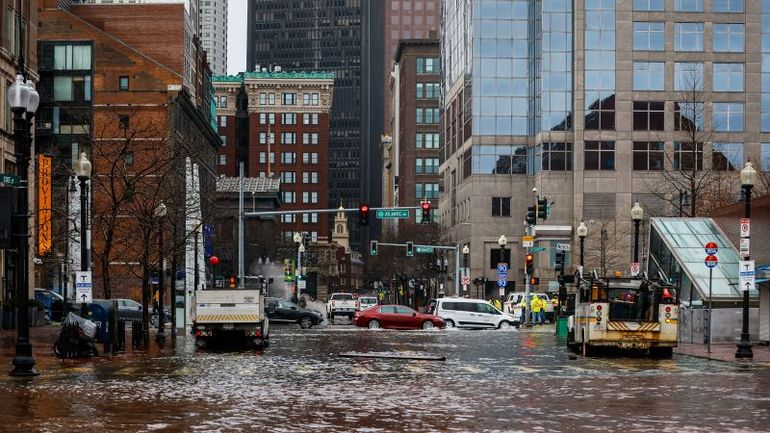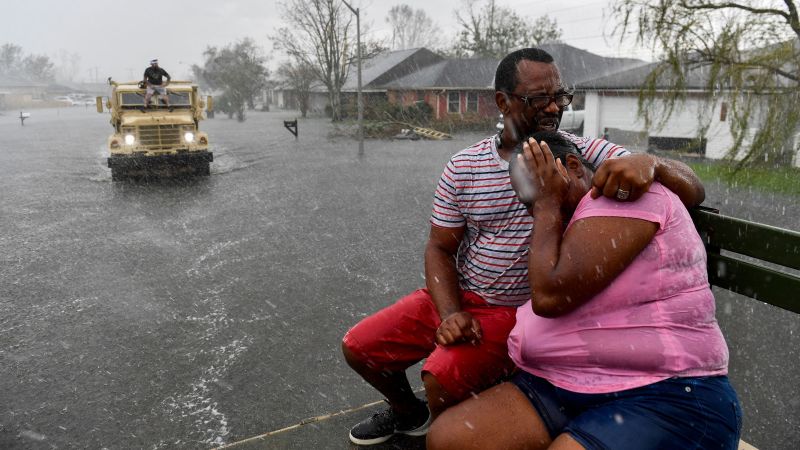
Rising Seas Threaten Coastal Cities with Accelerated Flooding

Recent findings reveal that coastal cities in the US are sinking, intensifying their vulnerability to sea level rise-induced floods. This new research underscores the urgent need for adaptation strategies to mitigate the escalating risks.
Dozens of cities along the US coastline are sinking at alarming rates, leaving them far more exposed to devastating flooding from sea level rise than previously thought, scientists reported Wednesday.
As oceans rise and the coasts sink, up to 343,000 acres of land will be exposed to destructive flooding by 2050, from hazards such as hurricanes, coastal storms and shoreline erosion, according to the study published in the journal Nature. In a worst-case scenario, roughly 1 in 50 people in the 32 cities analyzed could be exposed to flood threats.
This study, according to researchers, is the first to combine the threat of sea level rise with detailed measurements of sinking areas to identify the coastal locations most at risk of flooding. Manoochehr Shirzaei, a geophysicist at Virginia Tech and co-author of the study, expressed that every finding from this research is new and groundbreaking.
The lead author of the study, Leonard Ohenhen, a doctoral researcher at Virginia Tech, pointed out that the impact of sinking land has been underestimated. He highlighted that the combination of land sinking on the coast and sea level rise will lead to more areas being vulnerable to flooding in the future, as shared with CNN.
Cities on the East Coast experiencing sinking land and worsening sea level rise include New York City, Atlantic City, Virginia Beach, Charleston, and Savannah.
Researchers have found that many cities along the Eastern Seaboard, even those not affected by sinking land, are at a greater risk of coastal flooding due to the lack of physical protection.
The study reveals that a significant portion of the Gulf Coast is sinking at a rapid pace. However, the number of individuals at risk of flooding is lower compared to the densely populated East Coast. According to the report, up to one-third of the sea level rise in this area within the next thirty years could be attributed to the sinking effect.
In the Gulf region, southern Louisiana and southeast Texas, including Galveston, Freeport, and Corpus Christi, are identified as high-risk areas for land subsidence.
Coastal cities are sinking due to groundwater extraction being one of the main causes. This is because cities and industries are drawing water from underground aquifers at a faster rate than it can be naturally refilled. Climate change-induced drought worsens this situation. When too much water is pumped out, it lowers the water table and leads to the land above sinking.
When oil and gas are extracted from underground, the Gulf Coast is filled with on and offshore facilities. These facilities not only worsen the climate crisis by contributing to sea level rise but also play a significant role in causing land subsidence in the region.
Land subsidence in the Gulf Coast can also be triggered by seismic activity, soil compaction, or the weight of heavy buildings. In areas where new coastal land has been formed through sediment backfilling, the problem of sinking land becomes more pronounced.
A study last year found New York City is sinking under the weight of its own buildings.
The remnants of Tropical Storm Ophelia brought flooding across the mid-Atlantic and Northeast in late September, 2023, including the Hamilton Beach neighborhood in the Queens borough of New York City.
Tropical Storm Ophelia left a trail of flooding in late September, 2023, affecting the mid-Atlantic and Northeast regions. Among the areas impacted was the Hamilton Beach neighborhood in Queens, New York City.
Photo credit: Bing Guan/Reuters
"What I find fascinating is that flooding has become a matter of inches," mentioned Kristina Hill, an associate professor of environmental planning and urban design at the University of California, Berkeley. She pointed out that our choices are starting to have consequences, emphasizing the importance of considering land subsidence when designing protective barriers such as levees and sea walls.
TOPSHOT - People react as a sudden rain shower soaks them with water while riding out of a flooded neighborhood in a volunteer high water truck assisting people evacuating from homes after neighborhoods flooded in LaPlace, Louisiana on August 30, 2021 in the aftermath of Hurricane Ida. - Rescuers on Monday combed through the "catastrophic" damage Hurricane Ida did to Louisiana, a day after the fierce storm killed at least two people, stranded others in rising floodwaters and sheared the roofs off homes. (Photo by Patrick T. FALLON / AFP) (Photo by PATRICK T. FALLON/AFP via Getty Images)
People in a flooded neighborhood in LaPlace, Louisiana were caught in a sudden rain shower while being assisted by volunteers in a high water truck. The neighborhood was flooded after Hurricane Ida hit the area on August 30, 2021. Rescuers worked on Monday to assess the "catastrophic" damage caused by the storm, which resulted in at least two deaths, stranded individuals in floodwaters, and destroyed homes by ripping off their roofs. (Photo by Patrick T. FALLON / AFP) (Photo by PATRICK T. FALLON/AFP via Getty Images)
Related article
Black communities in the Southeast are more likely to be exposed to extreme weather events than overall population
Researchers have also investigated the communities that are most at risk from sinking land and rising sea levels. They discovered that people of color and low-income populations along the Gulf Coast are disproportionately affected by this threat.
According to the report, individuals identifying as Black or African American make up over half of those who will face exposure by the year 2050. This is despite the fact that they only represent around 29% of the total population in the region.
"In communities like New Orleans and Port Arthur, the median property value tends to be lower," explained Ohenhen. "This indicates a higher population of residents with lower incomes in these areas projected for 2050."
Pedestrians stand at the inundated entryway of a Publix supermarket as a deluge of rain from a tropical storm in 2022 caused flooding in Miami.
Pedestrians stand at the inundated entryway of a Publix supermarket as a deluge of rain from a tropical storm in 2022 caused flooding in Miami.
Joe Raedle/Getty Images
Cities must consider land subsidence as they address the effects of the climate crisis and safeguard their communities from the increasing risk of sea level rise. Researchers warn that failing to consider land subsidence could result in inaccurate predictions of potential vulnerability.
Furthermore, the majority of studies on sea level rise focus on projections for the end of the century, which many view as too distant to start planning, according to Shirzaei.
It’s a matter of knowing the risk and being proactive, he said, rather than waiting for an extreme event to happen to make changes.
Editor's P/S:
This article highlights the alarming rate of sinking coastal cities in the US, exposing them to devastating flooding from sea level rise. The combination of land subsidence and rising sea levels poses a significant threat to coastal communities, particularly those already facing socioeconomic disparities. The study's findings underscore the urgent need for proactive planning and mitigation strategies to protect vulnerable populations and infrastructure from the escalating risks.
It is deeply concerning that communities of color and low-income populations are disproportionately affected by this threat. The intersectionality of climate impacts and social inequalities demands attention and action. Cities must prioritize equity in their planning and response efforts to ensure that all residents have access to adequate protections and resources.












